AUSTRIAN 'APFELSTRUDEL' (APPLE STRUDEL)
Layers of crispy thin pastry, wrapped around soft and tangy-sweet cinnamon-scented apple slices... 'Apfelstrudel'. Another traditional Austrian dish, with, according to Wikipedia, its oldest known recipe, hand-written and dating back to 1696, housed at the 'Wiener Stadtbibliothek', the Vienna City Library. Due to its popularity and the centuries it has been around, there are many versions of it worldwide, but this recipe is my favourite. It's the one from home, like my mum makes it, so no surprises there I guess :-) And on top of that, to make my Strudels, I actually use one of her very old tablecloths that we used for our every day dinner table when I was a child - oh the childhood memories... sigh! :-)
For me, Apfelstrudel has to be made from scratch, including the pastry. I really think it is not that difficult, nor does it take a long time - at least not difficult or long enough to replace it with shop-bought pastry sheets that always have a different consistency and taste in comparison. It just needs a little practice, patience (and some patching, if all fails...). I think it's actually quite fun when you do get the hang of it and you realize how thin and wide the dough lets you pull it. And the end result is so rewarding, plus you do get a big Strudel so a lot to enjoy afterwards.
For me, Apfelstrudel has to be made from scratch, including the pastry. I really think it is not that difficult, nor does it take a long time - at least not difficult or long enough to replace it with shop-bought pastry sheets that always have a different consistency and taste in comparison. It just needs a little practice, patience (and some patching, if all fails...). I think it's actually quite fun when you do get the hang of it and you realize how thin and wide the dough lets you pull it. And the end result is so rewarding, plus you do get a big Strudel so a lot to enjoy afterwards.
Just don't be put off by my photos: I read somewhere that you should roll the dough out a little, brush with melted butter, cover, and leave it to rest again before stretching, as this will make the dough even more elastic. I did this, and the dough was very elastic, but it seems that the butter created a hard layer on top. This layer then pulled into tiny blobs all over the pastry making it look like goose pimple skin :-) Although it made us come up with all sorts of names and comparisons, luckily it made no difference to the taste, if anything, the butter was nicely spread across the whole dough... it just looks really strange, especially in the pictures... :-)


Also, the ready-baked-naked Strudel just out of the oven: mine was a little bit too long to fit straight on the baking tray, and I was too stubborn to lay it in a crescent (or U-shape, as you should normally do in this case), so I squeezed it together to fit it straight. This resulted in the most unsightly folds all over the top and it looked more like a ginormous worm. Looking at the picture I am expecting it to crawl off the baking tray any second. I was hesitating to share it, especially when starting to see the resemblance with a sea gherkin we photographed a couple of years ago - but what the heck, here they are both... :-)


It might not be eye candy at this stage, but it sure is once it has received its sugar dusting and is cut into slices... not enough... need to make soon again... :-)
PS, if Strudel to be served as 'dessert-and-late-piece-of-birthday-cake' to one of your friends, do not attempt to put candles into the hot Strudel as they will most certainly melt and quickly start to lean in all directions... yes, I know, should have known better... ;-)
Recipe source: Mutti (my mum)
Strudel Dough:
200g flour, smooth
1 Tbsp oil
125ml water
1/4 - 1/2 tsp salt
Additional flour for dusting
Butter for brushing
Icing sugar for dusting
Filling:
app. 1.25 - 1.5 kg cooking apples (slightly sour) = app. 1kg weight once peeled and core removed
80g sugar, or a little more if apples are very sour
2 tsp cinnamon
juice of app. 1/2 to 1 lemon
100g raisins
3 Dsp (30ml) rum (optional)
120g breadcrumbs
120g butter
Also: large baking tray (30x40cm) and a tablecloth (or sufficiently large kitchen towel)


First of all soak the raisins: put them into a small bowl, add the rum and stir. Place into the microwave for a few seconds just until the rum and raisins are a little warm then leave to infuse, stirring occasionally.
Prepare the dough: Sift the flour together with the salt onto a pastry board ('Nudelbrett') or work surface. Make a big well in the middle. Warm the water until hand-warm. Add the oil and the water to the well. Stir the liquids with a fork, thereby adding more and more flour from the side.


When the mixture gets too stiff to combine with the fork, use your hands to incorporate the remaining flour and knead until you have a dough that comes easily off the surface and your hands. If necessary add water of flour by the spoonful to make it more moist or dry. Then beat the dough: to do this, pick up the dough with both hands, lift it up high above your head and then slam it with full force back onto the pastry board. Do this as many times as necessary, kneading every so often in between, until the dough becomes soft and smooth with a silky texture and surface (I like to compare it with an ear lobe...). This aligns the gluten strands, enabling the dough to be stretched much more later. I know this sounds strange, but really does do the trick and you will see and feel the difference.

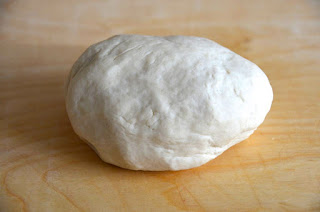
Put the dough onto an oiled plate, flatten it a little, brush well with oil, then cover with a large enough bowl that has been rinsed with boiling water. This will ensure that the dough does not dry out. Leave to rest at room temperature for app. 30 minutes.


Meantime, prepare the filling. For the breadcrumbs, melt the butter in a large non-stick frying pan, add the breadcrumbs and fry over medium heat, stirring often, until the bread crumbs are golden brown. Remove from the heat and leave to cool.
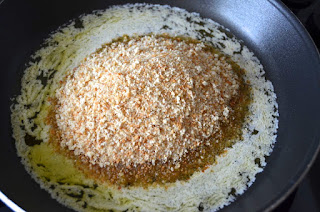

Pre-heat the oven to 190°C/fan 170°C. Prepare the apple filling: Peel the apples, then grate them into thin slices with a Mandoline or grater. I slice them whole, leaving the core behind at the end. Once in the bowl, I break them up a little with a spoon to make the slices smaller. You can also cut the apples into quarters first, remove the core and then grate them. Put the apple slices into a large bowl, stirring them with a little lemon juice as you go along to prevent them from browning. Add the cinnamon, raisins, sugar, and remaining lemon (add more or less sugar and/or lemon depending on the sweetness or sourness of the apples used; the mixture should be sweet but with a pleasant tang). Mix well.


Roll out the dough: Place a tablecloth or large kitchen towel on a table. Dust well with flour. Put the dough in the middle, dust with flour on top then roll out into a large rectangular shape with a flour-dusted rolling pin. Then stretch it further, using the back of your floured hands: to do this, place your hands underneath the dough, with the back of your hands underneath the dough, then pull the dough gently by moving your hands apart or outwards from the centre, always pulling strong enough to stretch, but gentle enough to not tear and create holes (in case this happens, just use smaller pieces of stretched dough later to patch up the holes). Stretch first the middle of the dough then do the sides. Not all of the border can be stretched and you will end up with a small edge of thicker dough around the side. Try to stretch this a little more with your finger tips, then cut off any remaining thicker edges with a dough cutter at the end.


Once the dough is fully stretched - it should be as thin as Filo pastry and you should see the pattern of the table cloth through - or be able to read a newspaper through it, as we say :-), sprinkle the cooled breadcrumbs on top and spread out evenly, leaving a small rim around the dough empty. Spread the apples evenly on top.


Roll the Strudel with the aid of the table cloth: lift up the table cloth on one side together with the dough and fold it inwards to create the first Strudel flap. As you keep lifting the cloth further, the Strudel will roll itself up automatically. Pinch the ends together well and tuck them under the Strudel, then lift the Strudel onto the baking tray seam side down. This is important so that the Strudel does not open during baking.

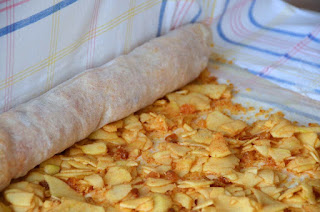
Brush the Strudel with melted butter, put it in the pre-heated oven and bake until golden brown, app. 40-50 minutes. When the Strudel starts to sink down it is a sign that the apples are softening. Towards the end of baking time take the Strudel out of the oven, brush again with melted butter, sprinkle with icing sugar and put back in the oven. This will create a crispy sugar-crunchy layer. Once the Strudel is baked, remove it from the oven and sprinkle again with icing sugar.




Best served warm, sprinkled with icing sugar, with vanilla ice cream, whipped cream or warm vanilla custard.
________________________________________________________
AUSTRIAN 'APFELSTRUDEL'
(APPLE STRUDEL)


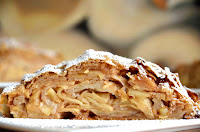
Strudel Dough:
200g flour, smooth
1 Tbsp oil
125ml water
1/4 - 1/2 tsp salt
Additional flour for dusting
Butter for brushing
Icing sugar for dusting
Filling:
app. 1.25 - 1.5 kg cooking apples (slightly sour) = app. 1kg weight once peeled and core removed
80g sugar, or a little more if apples are very sour
2 tsp cinnamon
juice of app. 1/2 to 1 lemon
100g raisins
3 Dsp (30ml) rum (optional)
120g breadcrumbs
120g butter
Also: large baking tray (30x40cm) and a tablecloth (or sufficiently large kitchen towel)
1) Soak the raisins: First of all soak the raisins: put them into a small bowl, add the rum and stir. Place into the microwave for a few seconds just until the rum and raisins are a little warm then leave to infuse, stirring occasionally.
2) Make the dough: Prepare the dough: Sift the flour together with the salt onto a pastry board ('Nudelbrett') or work surface. Make a big well in the middle. Warm the water until hand-warm. Add the oil and the water to the well. Stir the liquids with a fork, thereby adding more and more flour from the side. When the mixture gets too stiff to combine with the fork, use your hands to incorporate the remaining flour and knead until you have a dough that comes easily off the surface and your hands. If necessary add water of flour by the spoonful to make it more moist or dry.
3) 'Beat' the dough: To do this, pick up the dough with both hands, lift it up high above your head and then slam it with full force back onto the pastry board. Do this as many times as necessary, kneading every so often in between, until the dough becomes soft and smooth with a silky texture and surface (I like to compare it with an ear lobe...). This aligns the gluten strands, enabling the dough to be stretched much more later. I know this sounds strange, but really does do the trick and you will see and feel the difference.
4) Rest the dough: Put the dough onto an oiled plate, flatten it a little, brush well with oil, then cover with a large enough bowl that has been rinsed with boiling water. This will ensure that the dough does not dry out. Leave to rest at room temperature for app. 30 minutes.
5) Fry the breadcrumbs: Meantime, prepare the filling. For the breadcrumbs, melt the butter in a large non-stick frying pan, add the breadcrumbs and fry over medium heat, stirring often, until the bread crumbs are golden brown. Remove from the heat and leave to cool.
6) Pre-heat the oven to 190°C/fan 170°C.
7) Grate the apples: Peel the apples, then grate them into thin slices with a Mandoline or grater. I slice them whole, leaving the core behind at the end. Once in the bowl, I break them up a little with a spoon to make the slices smaller. You can also cut the apples into quarters first, remove the core and then grate them. Put the apple slices into a large bowl, stirring them with a little lemon juice as you go along to prevent them from browning.
8) Add sugar and spices: Add the cinnamon, raisins, sugar, and remaining lemon (add more or less sugar and/or lemon depending on the sweetness or sourness of the apples used; the mixture should be sweet but with a pleasant tang). Mix well.
9) Roll out the dough: Place a tablecloth or large kitchen towel on a table. Dust well with flour. Put the dough in the middle, dust with flour on top then roll out into a large rectangular shape with a flour-dusted rolling pin.
10) Stretch the dough: Then stretch the dough further, using the back of your floured hands: to do this, place your hands underneath the dough, with the back of your hands underneath the dough, then pull the dough gently by moving your hands apart or outwards from the centre, always pulling strong enough to stretch, but gentle enough to not tear and create holes (in case this happens, just use smaller pieces of stretched dough later to patch up the holes). Stretch first the middle of the dough then do the sides. Not all of the border can be stretched and you will end up with a small edge of thicker dough around the side. Try to stretch this a little more with your finger tips, then cut off any remaining thicker edges with a dough cutter at the end. Once the dough is fully stretched - it should be as thin as Filo pastry and you should see the pattern of the table cloth through - or be able to read a newspaper through it, as we say :-).
11) Sprinkle the breadcrumbs on top: Sprinkle the cooled breadcrumbs on top and spread out evenly, leaving a small rim around the dough empty.
12) Add the apple filling on top: Spread the apples evenly on top.
13) Roll the Strudel: Roll the Strudel with the aid of the table cloth: lift up the table cloth on one side together with the dough and fold it inwards to create the first Strudel flap. As you keep lifting the cloth further, the Strudel will roll itself up automatically. Pinch the ends together well and tuck them under the Strudel, then lift the Strudel onto the baking tray seam side down. This is important so that the Strudel does not open during baking.
14 ) Brush with melted butter: Brush the Strudel with melted butter.
15) Bake: Put it in the pre-heated oven and bake until golden brown, app. 40-50 minutes. When the Strudel starts to sink down it is a sign that the apples are softening. Towards the end of baking time take the Strudel out of the oven, brush again with melted butter, sprinkle with icing sugar and put back in the oven. This will create a crispy sugar-crunchy layer.
16) Sprinkle with icing sugar: Once the Strudel is baked, remove it from the oven and sprinkle again with icing sugar.
17) Serve: Best served warm, sprinkled with icing sugar, with vanilla ice cream, whipped cream or warm vanilla custard.


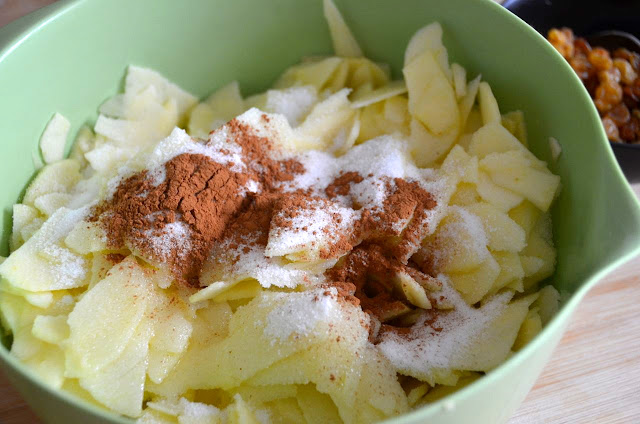



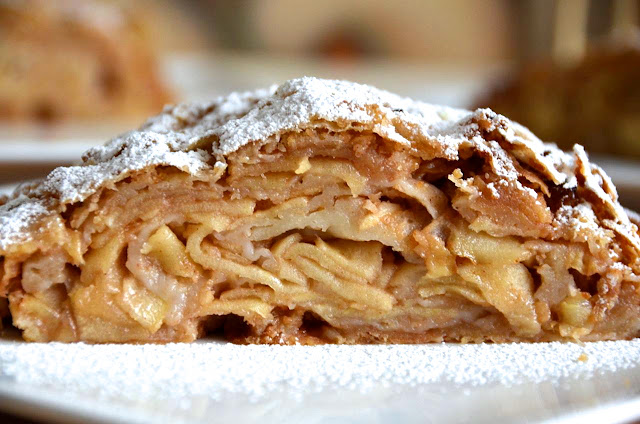


The description makes me want to try this recipe.
ReplyDelete